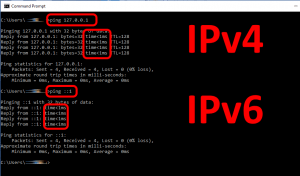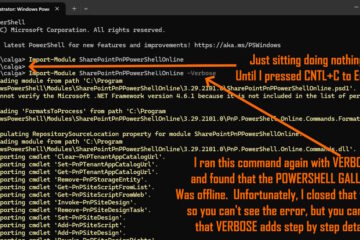If you are working on a network you are going to see some IPv6 traffic and it can get quite confusing. A “loopback” is an address that causes the traffic to be sent to the same interface is was sent out on on the localhost.
 Usage of loopback addresses are particularly popular with developers and anyone in IT performing network tests. For instance, if you think your Network Card is failing you can try:
Usage of loopback addresses are particularly popular with developers and anyone in IT performing network tests. For instance, if you think your Network Card is failing you can try:
PING 127.0.0.1
and if you don’t see a reply with a TIME<1ms, your card or TCP/IP stack likely has a problem. If you are on a PC that supports IPv6 (all Windows 10, 8, 7 and Vista PC’s), you can try the same test using:
PING ::1
Below are all of the loopback IP addresses:
- IPv6 = 0:0:0:0:0:0:0:1
- IPv6 = 0:0:0:0:0:0:0:0
- IPv6 = 0:0:0:0:0:ffff:7f00:1
- IPv6 = ::1
- IPv6 = ::
.
. - IPv4 = 127.0.0.1 to 127.255.255.255
Below is a table of all the ‘Special Use’ IP Ranges:
0.0.0.0/8 “This” Network
10.0.0.0/8 Private-Use Networks
14.0.0.0/8 Public-Data Networks
24.0.0.0/8 Cable Television Networks
39.0.0.0/8 Reserved, subject to allocation
127.0.0.0/8 Loopback
128.0.0.0/16 Reserved, subject to allocation
169.254.0.0/16 Link Local
172.16.0.0/12 Private-Use Networks
191.255.0.0/16 Reserved, subject to allocation
192.0.0.0/24 Reserved but subject to allocation
192.0.2.0/24 Test-Net
192.88.99.0/24 6to4 Relay Anycast
192.168.0.0/16 Private-Use Networks
198.18.0.0/15 Network Interconnect Device Benchmark Testing
223.255.255.0/24 Reserved, subject to allocation
224.0.0.0/4 Multicast, commonly used in multiplayer simulations and gaming and for video distribution.
240.0.0.0/4 Reserved for Future Use
.



0 Comments